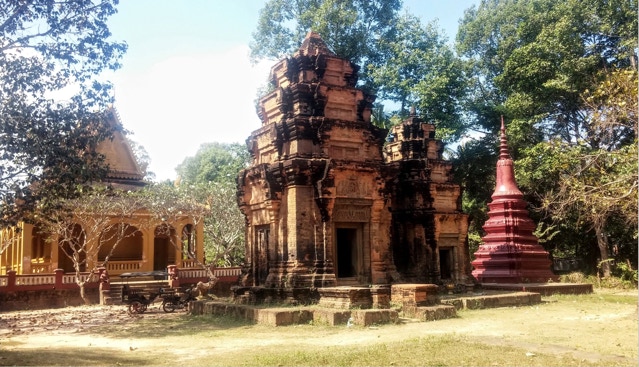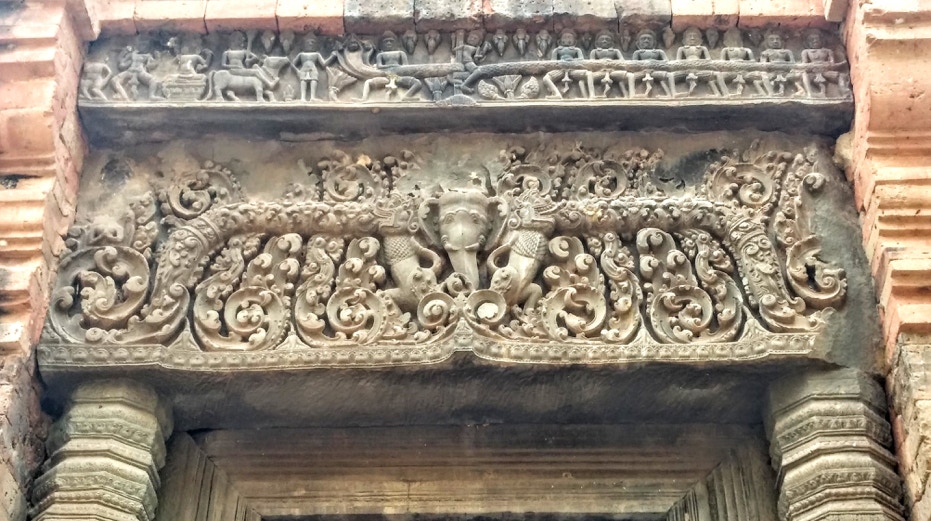PREI
ENKOSEI
(968)

PREI
ENKOSEI
(968)

Kavindrarimarhana, the architect of Pre Rup and sponsor of Bat Chum, and Yainavaraha, the king's spiritual teacher and his son’s tutor, who built Banteay Srei, were not the only notables at Rajendravarman I's (944-068) court granted permission to construct their own temples. Divarkarabata, another brahmin and the monarch's son-in-law, built the two prasats of this small temple, Prei (Preah) Enkosei. Historians have speculated that the two high officials may, in fact, have been rivals. Divarkarabata was born into the brahmin gotra or family responsible for the secret devaraja cult since Jayavarman II initiated it in 802, and hence possessed an independent authority stretching back before the present king and dynasty. Rajendravarman may have arranged a marriage for him with his daughter to render the brahmin family ineligible for presiding at future abhikesha ceremonies, thus opening the position to Yainavaraha and his heirs. These machinations suggest the increased importance of imperial administrators resulting from the king's reassertion of central authority at Angkor, after its usurpation by Jayavaraman IV (928-944.) Thus Rajendravarman would have both increased his officials' prestige while, at the same time, making that prestige dependent solely on his favor.
Two dedicatory inscriptions date Prei Enkosei to the year of Rajendravarman's death, stating that it was part of a seminary endowed with land and 175 slaves to work it. Only two of a probable three prasats were constructed since the southern of the pair is on axis with the ruined 1st east gopura and larger than the one to its north; (a similar inference implies that six rather than the present four were planned at Lolei.) The two extant shrines follow the familiar Khmer prasat type, a pancharatha cella with a pyramid of four aedicular tiers as a shikhara.
Prei Enkosei is the only Angkorian temple located inside the city of Siem Reap and the only one not governed by the APSARA authority. Like Wat Athvea and Lolei, also separate from the main archaeological park, the Hindu shrine has been incorporated into a modern Buddhist wat whose vihara or "congregational hall" (Sans. > vihara; Kh.> vihear; Thai> wihan; Bur. > phaya ) is the yellow, wooden building with a veranda at left. Its very modest red stupa, (Kh. > caedai; Thai > chedi; Bur.> zedi) containing a relic of Buddha or a distinguished follower, is at right. A stupa has analogies with a "temple mountain;" it usually has a square, redented or octagonal base tapering in diminishing convex tiers or circles, its anda (Sans. > egg,) then turning concave as the stupa's tip or finial. It symbolizes a bell and its handle ringing out dharma, the path to enlightenment, to the world.

EAST-FACING LINTEL, PREI ENKOSEI (968)
The remaining lintel at Prei Enkosie is not as well-carved or peserved as those at the royal temples, East Mebon or Pre Rup, or the superlative pediments of Banteay Srei. It shows Indra, king of the Vedic pantheon, on a single-headed elephant rather than his usual three-headed mount, Airavata, one of the ratna or "jewels" stirred up from "The Churning of the Ocean of Milk." (Perhaps three-headed elephants were reserved for temples of the Khmer King.) The god is flanked by two leogryphs or simhas from whose mouths an unbent garland flows, its inward-scrolling volutes topped with the remnants of praying devotees; there are no kalas, makaras or nagas. Above the lintel, a narrow, crudely-carved frieze depicts devas and asuras twisting the serpent Vasuki to churn the ocean of milk from which Airavata, pictured below, emerged. This may be the most frequently carved subject in Khmer bas relief; although it usually fills the pediment above the lintel, it can only with difficulty be accommodated in a narrow, horizontal format. Vishnu figures prominently in this myth, organizing the usually antagonistic devas and asuras in a common purpose, while holding Mt. Mandara as the pivot on top of his second avatar, the tortoise Kurma, around which the naga, Vasuki, another of his manifestations, akin to Sesha/ nanta, is twisted (see appendix VI on Vishnu's Dashavatara.) Shiva on Nandi, a god or goddess meditating on a lotus pod in lotus position (Brahma?) and a menacing figure look on from the left.
54